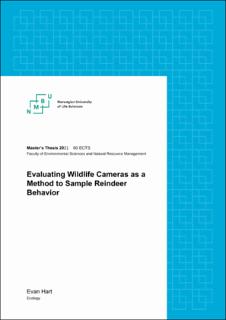| dc.description.abstract | Increasing amounts of infrastructure intersecting reindeer habitat in Fennoscandia also increases concern over negative effects on reindeer behavior and area use. Previous studies have shown variable results regarding area use, often related to spatiotemporal scale, while research on the effects of infrastructure on reindeer behavior has been limited. Can wildlife cameras contribute novel data? I analyzed data from wildlife cameras near power lines in two reindeer herding districts in Trøndelag and Nordland counties, Norway to investigate the reliability of wildlife cameras in identifying behavior and area use patterns, comparing with GPS collar data from the same sites and scales. Animal behavior data from wildlife cameras was used to test proportions of behavior types against habitat and distance to the line, compared with movement rate data from GPS collars. Meanwhile, presence/absence analysis based off camera data was used to identify area use relative to distance from power lines, compared with area use analyses based off GPS positions. Camera and GPS-data agreed in finding no significant negative effects by power line proximity on animal stress or relaxation behaviors, however camera data found behavior patterns not detected using GPS-data. Results were generally consistent between cameras and GPS-data for area use, finding no negative effects by power lines, however the limited scale and detail of the camera data, especially at the Trøndelag site, limited the power of results. Results suggest that cameras are a useful tool for the analysis of behavior relative to infrastructure, while camera data is likely more useful as a supplementary data source for area use analysis when alternative methods are limited. Potential issues with data handling and study design were also identified, which future studies using this technology can take into consideration. It is recommended that wildlife cameras be further applied and developed in this context in order to better inform management of reindeer populations. | en_US |

